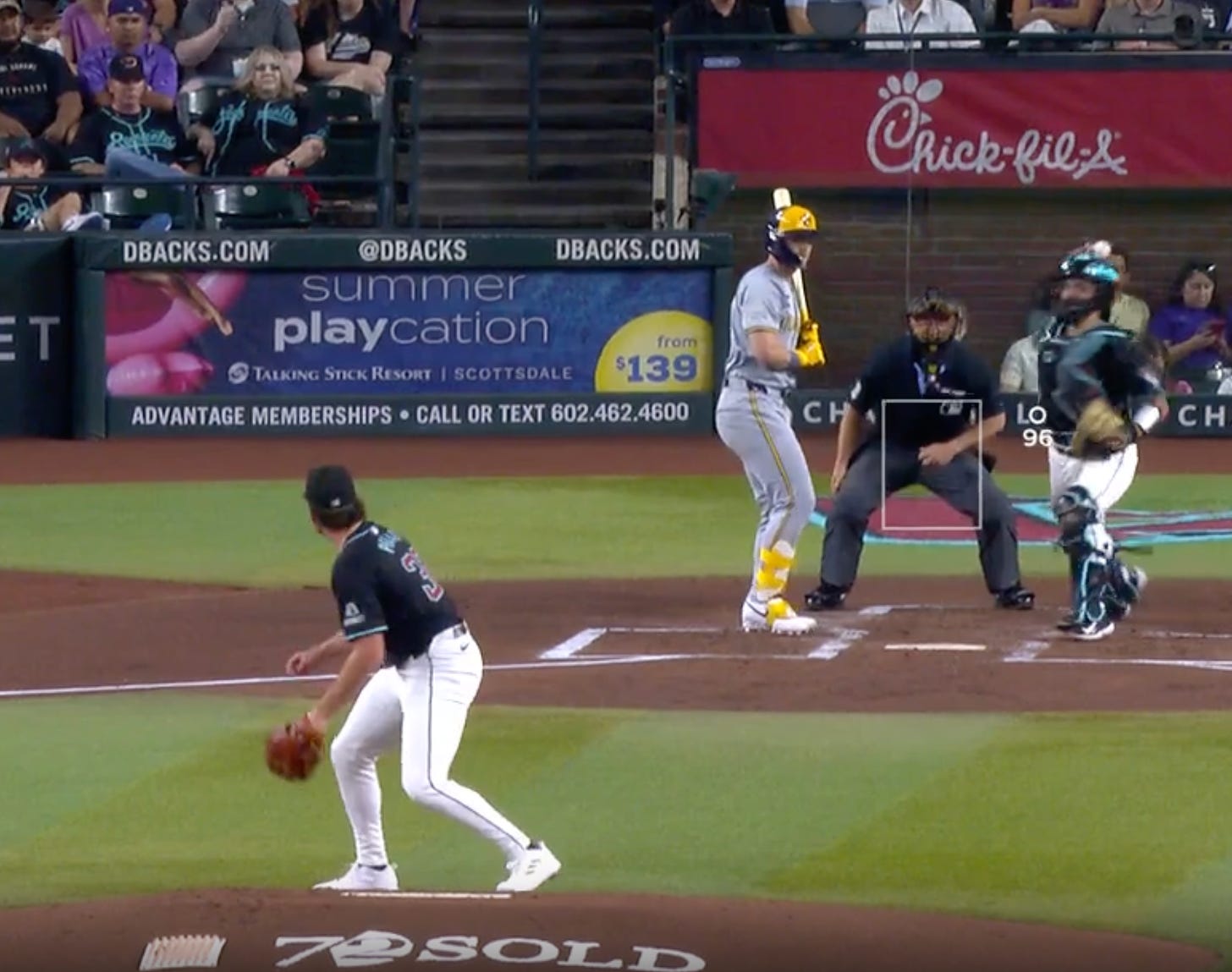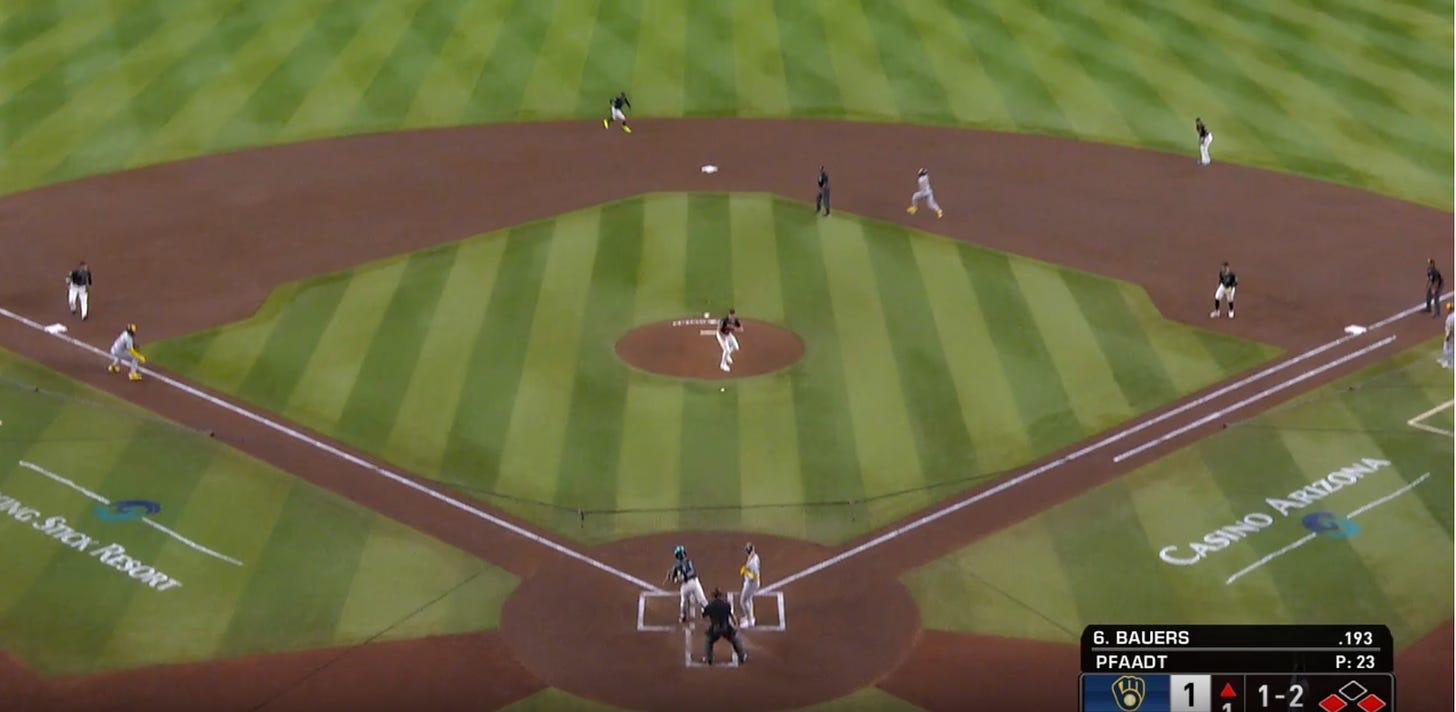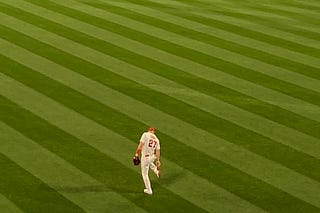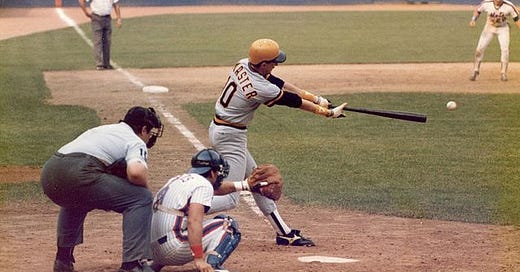

Discover more from Pebble Hunting
Two things happened this weekend that are of special interest to me and perhaps to recent readers of me. One is that a right-hander hit a baseball into McCovey Cove, answering the question I asked in a headline two months ago: Can A Righty Reach McCovey Cove? The other is that, in a first-and-third situation, with the runner on first attempting to take his automatic stolen base, a team finally tried the Little-League-honed strategy that seems like it just might be the best answer to this defensive conundrum. Let’s do these very quickly:
Heliot Ramos’ splash hit.
Three takeaways from the first splash hit by a righty:
1—
Dude, Mike Krukow! The only reason I wrote about this topic this year is because Krukow has been going on about Heliot Ramos’ chances of doing this very thing, of doing the thing that nobody had done in the 2,000-game history of the park. Krukow looked at young Heliot Ramos and could almost immediately envision all the possibilities of that swing, almost immediately recognized the highly specific event he would be able to create. I don’t remember Krukow constantly talking about “nobody’s ever hit a splash hit from the right side” when Hunter Pence was batting, or Pat Burrell or Buster Posey or Darin Ruf or what have you. Just Ramos. A few dozen games into Heliot Ramos’ career, Krukow had already intuited the man’s significance in this sport, and he was right. I like to think I know a few things about baseball. And that’s correct. I know a few things about baseball. Krukow knows all things about baseball.
2:
Krukow put it like this afterward: “You think about the perfect storm. Around the eighth inning the wind shifted and it started going out to right center. Then you’ve got a guy on the mound who is throwing 100 mph and you’ve got a guy at the plate with great power and a great right field approach. It all lined up and it had to be perfect and it was.”
There’s a lot to what he says, but I also want to note that it was neither totally perfect—it wasn’t right down the right field line—nor did it have to be, since it went 394 feet, a good 20 feet past the minimum required to get to the water. In a sense, Ramos showed how eaaaaaasy it should be. I’m confident Ramos could have done that without the wind, is what I’m saying.
Now, the Giants haven’t had many right-handed hitters in the past 25 years who could hit a ball 394 feet almost down the right-field line. I listed a few of their recent right-handed power hitters a couple paragraphs ago, and… I mean, I named Darin Ruf, that’s how rough it’s been for this club as far as RH power. So it makes sense that nobody on the home team has managed to do this in the team’s history. But it kind of defies belief that no visiting player has done it. Until we saw Ramos do it, we could at least hold out a little uncertainty about whether it was possible—after all, if [All The Great Power Hitters] hadn’t done it in 25 years, maybe truly it couldn’t be done. But then Ramos did it, quite easily, and Ramos isn’t exactly The Great Power Hitter. He’s got good power, but not historic power. His hardest-hit ball this year is the league’s 654th hardest-hit ball. Visiting right-handed power hitters of the past 25 years should be feeling kind of sheepish today.
3.
So, as it happens, I was up in the Bay Area this weekend for an article idea I had. And as it happens, my best friend and I went up to the City to kick it outside the stadium during a Giants game. Now, as it happens, we happened to be hanging out on a bench, on that walkway behind right field, about 25 feet from Dave in the kayak out there. And as it happens we heard the PA announce that Heliot Ramos was coming to bat. And I swear this is true, I thought of my article and in my head I said to myself, “it’d be pretty cool if Heliot Ramos picked this moment to hit the first splash hit by a right-handed batter, right over my head, into the water just a few feet away from me.” And then RAMOS ACTUALLY DID IT! Seventeen hours later. (We were at the Saturday night game.)
The Diamondbacks Little Leagued The Little League Stolen Base
The Diamondbacks on Saturday defended a first-and-third stolen base attempt with the ol’ catcher throws to second but pitcher cuts the throw off, spins and catches the runner on third who took off for home play. You remember that play, from the time you tried it in Little League and ended up with two fewer teeth and somehow both runs scoring.
I had expressed skepticism that this play would work, because—I figured—for the catcher to make the throw convincing, he would have to throw it really hard and the pitcher would have to… I don’t know, feign disinterest until the very last second? Which the Diamondbacks did!
And it totally worked:
Three questions here—
1,
If they do this a few times, will it stop teams from trying the first-and-third Little League stolen base? I don’t have an answer here. I’ll be curious to see whether this is a strategy that stops the running, or simply cuts into the value of the stolen base a litttttttle bit by picking up an out once or twice a year.
The key thing is that the defense still has to choose which runner to go after before knowing what the lead runner’s intentions are. If the pitcher cuts this throw off, and the runner on third doesn’t go home—the runner on third usually doesn’t go home, even on throws all the way to second—then this plays no differently than the catcher pump faking. It’s a non-attempt at the runner going to second, a free base for the runner going to second. So it doesn’t actually disinhibit the runner taking second in any way. This play ONLY matters if the runner on third breaks. He won’t break all the time, or even most of the time.
But he will break some of the time. So it’s about hunting outs.
Now, the standard instruction to the runner on third has always been “don’t break before the ball clears the pitcher’s head.” So theoretically this shouldn’t matter at all; if the pitcher cuts it off, he shouldn’t break anyway. But of course runners cheat a little, and even more than that, the body generates momentum before the break. In the play you just watched, the runner doesn’t break until after the ball has already been caught. But his body has already begun to commit in intention, in momentum, in preparation, and that was enough for him to get his self out.
2)
Is there any chance of verbal communication between the defenders, telling the pitcher when to cut the ball off—when the runner on third has started to commit—and when to let the throw go through to perhaps get the runner at second? I’m assuming not. I’m assuming (but I don’t know) that the catcher’s throw, to be cut off by the pitcher, isn’t even really aimed “at” second base, and therefore wouldn’t be a particularly accurate throw if the pitcher let it go through. I’m also assuming (but I don’t know) that it’s just way too touchy a play to tell the pitcher “cut it off but only if you hear the first baseman yell ‘cut!’ at the very very very last second.” That sounds impossibly complicated. But I don’t know for sure, and I’ll be watching to see.
No, I actually feel pretty confident that that would be impossible. Look at this scene, where the ball is maybe 10 feet from the pitcher and the runner still hasn’t broken in any meaningful way,
and tell me you think there’s any chance a fielder could communicate cut/no cut to the pitcher. But, yeah, fine, I’ll still be watching to see.
3.
How would you score this play?
You would score it a pickoff! Isn’t that funny to think, that to the scorebook this is actually just a standard pickoff, a pitch and then a throw back to the pitcher and then before his next pitch he throws a pickoff attempt to the base? Typical pickoff, to the scorebook. It’s funny to me. Nothing standard about this at all, to me.
***
Thanks to the many people who joyfully flagged these plays for me. You all know who you are and you’re the best.













I think you’d have to score it, SB 1-2, CS 3XH 2-1-5. Because he did break (a teeny bit) for home on a play that’s a double steal. This also seems slightly wrong, but it captures the spirit of the play better than a pickoff.
I was in the car driving in Marin between Sausalito and Larkspur this afternoon, and when looking at the map to see where my next turn was, I saw a notification from my friend pop up that said "righty splash hit!!!" and I couldn't think about much else until I parked. I knew it wasn't a big famous guy, because he would've mentioned the name, but I was curious who it was. to be honest, I was a bit crestfallen when I saw the name - I figured he was just some random guy, didn't even know if he was on the Giants or not, figured he was maybe some sort of journeyman and didn't look into it further. Very glad I read the beginning of this post - hearing that Krukow talked about this in advance makes it a much cooler story!